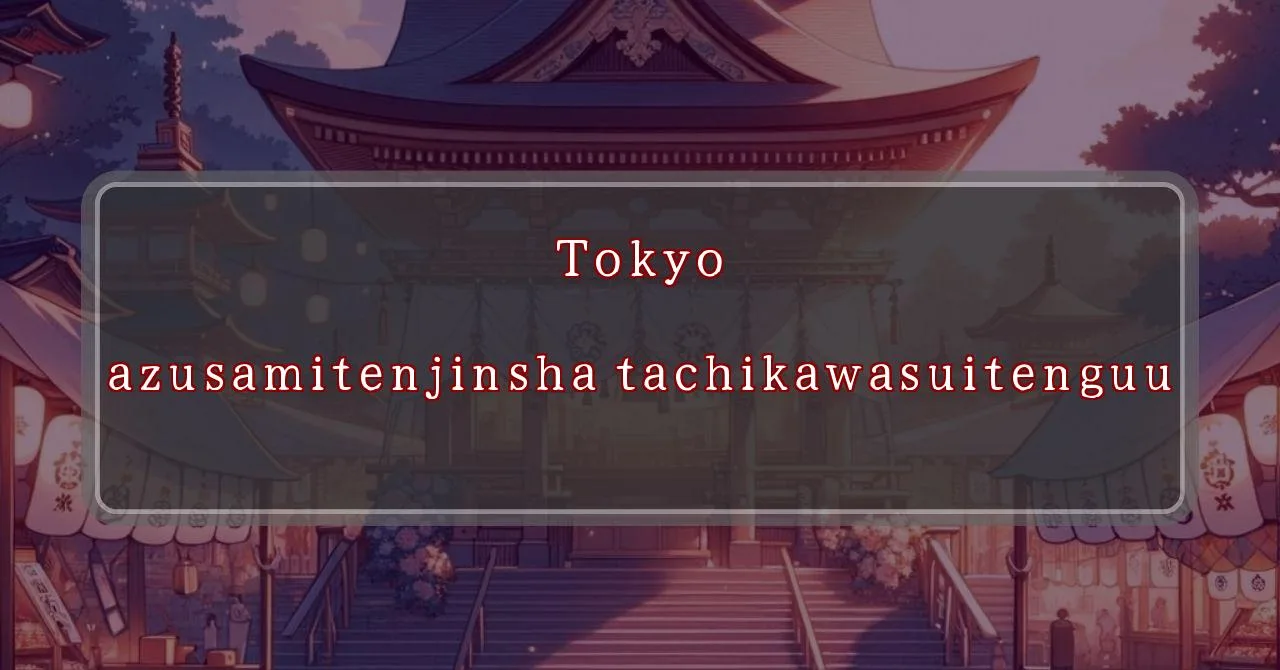Gleaming lights, divine spirits, prayers answered
Basic Information
A shrine where the gods of health, easy childbirth, and wisdom are enshrined.
- Address: 4-1-1 Sunagawacho, Tachikawa-shi, Tokyo 190-0031
- Phone Number: 042-536-3215
- Access: Take the bus from JR Tachikawa Station North Exit and get off at Sunagawacho 4-ban stop. It is a 15-minute walk from the bus stop.
- Festival Days: September 15th, 2024
Main Events and Attractions of the Festival
The main event of the festival is the Mikoshi Procession, where the portable shrine of the deity is carried through the streets. The procession is accompanied by traditional music and dance, and it is a lively and colorful spectacle.
Mikoshi Procession
The Mikoshi Procession is the highlight of the festival, where the portable shrine of the deity is carried through the streets. The procession is led by priests and shrine maidens, and it is followed by a large crowd of people. The procession is accompanied by traditional music and dance, and it is a lively and colorful spectacle.
- Overview: The portable shrine of the deity is carried through the streets.
- Participants: Priests, shrine maidens, and a large crowd of people.
- Accompaniments: Traditional music and dance.
- Atmosphere: Lively and colorful.
Kagura Performance
Kagura is a traditional Japanese dance and music performance that is often performed at Shinto shrines. The Kagura performance at the Azusamitenjin Tachikawa Suitengu Festival is a highlight of the festival, and it is a chance to see this traditional art form.
- Overview: A traditional Japanese dance and music performance.
- Location: Performed at the Azusamitenjin Tachikawa Suitengu Shrine.
- Significance: A chance to see a traditional art form.
Food Stalls
During the festival, there are many food stalls set up in the shrine grounds. These stalls sell a variety of traditional Japanese foods, such as yakitori, takoyaki, and okonomiyaki. There are also many stalls selling souvenirs and crafts.
- Overview: Many food stalls are set up in the shrine grounds.
- Food: Traditional Japanese foods, such as yakitori, takoyaki, and okonomiyaki.
- Other Items: Souvenirs and crafts.
Blessings and Deities
The deities enshrined at Azusamitenjin Tachikawa Suitengu are:
- Sukunahikona no Mikoto: The god of medicine, health, and wisdom.
- Amenokoyane no Mikoto: The god of literature, arts, and music.
People pray to these deities for good health, academic success, and prosperity in business.
Origin and History
The origins of Azusamitenjin Tachikawa Suitengu can be traced back to the year 1629, when it was founded as a branch shrine of the Azusamitenjin Shrine in Saitama Prefecture. The shrine was originally located in a different part of Tachikawa, but it was moved to its current location in 1939.
The shrine has a long history of serving the local community, and it is a popular destination for worshippers from all over the Tokyo area.
Tips and Notes for Visitors
- The festival is held on September 15th every year.
- The festival is a popular event, so it is advisable to arrive early to avoid crowds.
- There are many food stalls set up during the festival, so visitors can enjoy a variety of traditional Japanese foods.
- The shrine is located a 15-minute walk from JR Tachikawa Station. There is also a parking lot available for visitors.
Parking Information
There is a parking lot available for visitors to the Azusamitenjin Tachikawa Suitengu Shrine. The parking lot is located a short walk from the shrine.
- Location: A short walk from the shrine.
- Capacity: Approximately 32 cars.
- Fees: Free of charge.
Popular Stalls and Food Carts in Recent Years
| Type of Stall | Description |
|---|---|
| Takoyaki | A staple at Japanese festivals. Characterized by a crispy outside and a creamy inside. |
| Jaga Butter | A simple yet popular snack of hot potatoes lavishly topped with melted butter. |
| Baby Castella | Small castella cakes, sweet and fluffy treats enjoyed by children and adults alike. |
| Grilled Ayu with Salt | Fresh ayu fish grilled whole with salt, a savory taste of Japanese summer. |
| Shaapin | A unique gourmet item influenced by foreign cuisine, with a chewy skin wrapping the filling. |
| Okonomiyaki | A Japanese grilled dish where you often choose your own ingredients for a personalized flavor. |
| Cotton Candy | A fluffy, sweet snack that’s extremely popular with children. |
| Chocolate Banana | A banana coated in chocolate, a fun and visually appealing dessert. |
| Kushiyaki | Various types of ingredients skewered and grilled, an easy-to-enjoy snack. |
| Yakisoba | Fried noodles mixed with a special sauce, a fast food favorite in Japan. |



